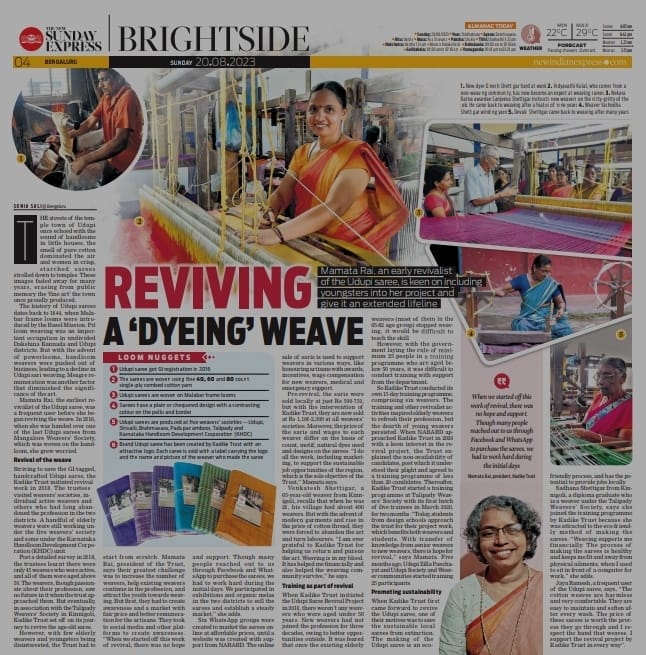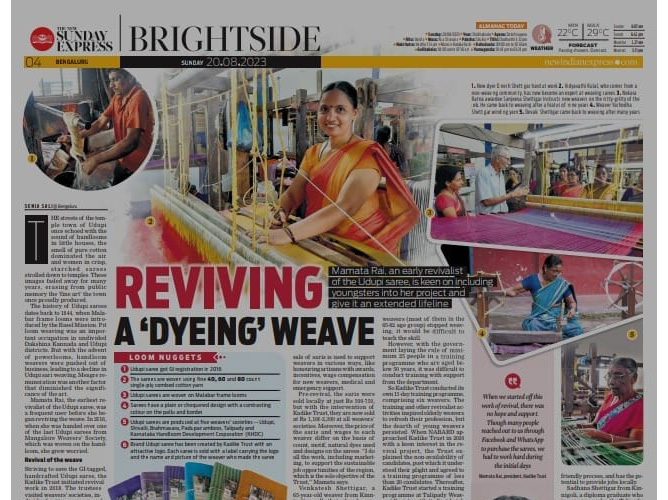
Sonia Sali @ Bengaluru
The streets of the temple town of Udupi that once resounded the sounds of the handloom in little houses, the smell of pure cotton that dominated the air and women in crisp, starched sarees that strolled down to temples faded away for long years, erasing from the memories of people the ‘fin art’ the town once proudly produced.
Weaving using pit looms was main occupation since long time in Undivided D.K and Udupi Districts . Weaving using Malabar frame loom dates back to 1844 when industrial training was introduced by the Basel Mission. But with the advent of power looms, handloom weavers were pushed out of business, impacting largely on the decline of the Udupi saree weaving . Owing to meagre renumeration, the art began to fade from public memory.
Mamata Rai the earliest revivalist of the Udupi saree in 2018, was a frequent user of the same before she initiated reviving the weave through Kadike Trust and bringing back weavers back into the game. In 2016, when she was handed over one of the last handloomed Udupi sarees from Mangalore Weaver’s Society, she was worried for the fading art that she was proud to adorn.
Revival of the weave
Striving to save GI tagged, handcrafted Udupi sarees, the Kadike Trust initiated revival work in 2018. The trustees visited weaver societies in two districts and individual active weavers and others who had long abandoned the profession in prospect of persuading them back into weaving. However, the concerned weren’t aware of the number of existing weavers nor was there enough information about the Udupi saree weaving. A handful of elderly weavers were still working under the 5 weavers’ society and some under the KHDC (Karnataka Handloom Development Corporation) unit.
Post a detailed survey in 2018, the trustees learnt that there were only 45 weavers who were active, with all of them above the ages of 50. The existing weavers though passionate about their profession saw no future in it when the trust approached them. With no youngsters in the field, the weaver societies saw no hopes in the revival of the fine, handcrafted, handmade Udupi sarees. But eventually, in association with the Talipady Weavers Society in Kinnigoli, Kadike Trust set off its journey to revive the age-old sarees.
However, with a handful of elderly weavers, the youth disinterested in handloom and the evident decline in the demand of the sarees, the trust had to start from the scratch. Mamata Rai, president of the trust says their greatest challenges were to increase the number of weavers, make existing weavers continue in the profession, make skilled weavers come back into weaving and to attract the youth towards weaving. To do so they had to first create awareness about ecofriendly Udupi sarees, create a market with fair price and better renumeration for the artisans. They used tools like social media and other platforms to bring awarenss. “When we started off this work of revival, there was no much hope and support. Though many people reached out to us through Facebook and WhatsApp to purchase the saree we had to work hard during the initial days. We participated in exhibitions and organic melas in two districts sell the sarees to establish steady market” she adds.
With word spreading, the demand for the sarees increased, benefitting all the five weaver societies in the district. Six WhatsApp groups were created to market the sarees online at affordable prices until dedicated website was created with the support from the NABARD. The online sale of sarees are used to support weavers in various ways like honouring artisans with awards , incentives, wage compensation to new weavers , medical support and in emergency . “I do all the works including marketing voluntarily to support this sustainable job opportunities of the region being the objective of the Trust ,” Mamata Rai opines. Previously, before the revival work by the trust, the sarees were sold locally at very low prices at Rs 500-750 but with the intervention of Kadike Trust , they are sold now at Rs 1100-2300 at all weavers Societies. Moreover, the price of the sarees and the wages to each weaver differ on the basis of count, motif, natural dyes used and designs on the sarees.
Venkatesh Shettigar, a 65-year-old weaver from Kinnigoli, recalls that when he was twenty, his village had about 400 weavers who weaved sarees. But with the advent of modern garments and rise in the prices of cotton threads, they were forced to abandon the art and take up daily-wage works. “I am ever grateful to the Kadike Trust for helping us come back and pursue the art. Weaving is in my blood and it comes very naturally to me. It has helped me financially but has also helped the weaving community survive” he says.
Training as part of revival
When the Kadike Trust initiated the Udupi Saree Revival Project in 2018 there weren’t weavers who were below 50 years. Nevertheless, new weavers had not joined the profession in the past three decades, owing to better opportunities outside. It was feared that once the existing elderly weavers (most of them in the age group 65-82) stopped weaving it would be difficult to teach the unique skill and a clear possibility of the extinction of the GI tagged saree weaving in Coastal Karnataka was foreseen. Therefore, training new people was a matter of urgency but finding youngsters was challenging, which is why the trust decided to conduct training programmes.
However, with the Government Department’s rules of minimum 25 people in a training programme who are below 50 years, it was difficult to conduct the training with support from the Department. Hence, Kadike Trust conducted its own 15-day training programme, consisting of 6 weavers. The training and other revival activities inspired elderly weavers to refresh their profession in weaving but the dearth of young weavers persisted. When NABARD approached Kadike Trust in 2020 with a keen interest in the revival project, the trust explained its situation of non-availability of candidates, post which it understood the plight and agreed to a training programme to a group of less than 20 candidates. Thereafter, training programme by Kadike Trust with support from NABARD at Talipady Weavers Society started with its first batch of five trainees in March 2020 for a period of two months. With the outbreak of the pandemic, the training was suspended but was continued again in June. In its second batch in 2020, five more people were trained. However, with due requests made to NABARD by the trust yet another six-month Skill Development Training Programme was started in December 2021.
With the previously trained 10 trainees, 9 more trainees participated in the same. The batch consisted of women who came back to the profession after a break of 20-30 years and youngsters who were entirely new to the art of weaving. One among them was given dye training since there were only two aged dyers in the coastal districts. After the training, they joined Talipady Society as member weavers.
Moreover, Kadike Trust has also supported many of them with wage compensations for more than a year. Consequently, new weavers have mastered the skills of weaving and are happily weaving.
Rai also says that the trust is planning to start training programmes to a group of youngsters who approached the Trust to strengthen and make them financially independent. “Today, a considerable number of youths are coming forward to learn the art. Students from design schools approaching Trust for their project works which benefits both weavers and students . With transformation of knowledge from senior weavers to new weavers, there is a hope for the revival,” she says. She adds that five months ago Udupi Zilla Panchayat along with Udupi Society and Weaver Communities started training 25 trainees in basic weaving.
Promoting Sustainability
When Kadike Trust, first came forward to revive Udupi sarees, one of their motives was to save the sustainable local sarees out of extinction. The making of Udupi saree is ecofriendly and has the potential to provide job locally and could be a step towards the solution for climate emergency . Natural dyeing introduced by the Trust enhances the Eco friendliness of the Udupi sarees. For Sadhana Shettigar from Kinnigoli, a diploma graduate who is a weaver under the Talipady Weavers Society says that she joined the training programme by Kadike Trust because she was attracted to the eco-friendly making of these sarees. “Weaving supports me financially. The process of making the sarees is healthy and keeps me fit and away from physical ailments unlike when I used to sit in front of a computer for work,” she adds.
Jaya Ramesh, a frequent user of the Udupi sarees says, “The cotton weaves are harmless and very comfortable. They are easy to maintain and softens after every wash. The price of these sarees is worth the process it goes through. I respect the hand that weaves and await ardently for the sarees once they are out of the loom. I support revival project by Kadike Trust in every way”. She also adds that Udupi sarees beautiful gifts to share with our dear ones.
Box
• Udupi Saree Got GI registration in 2016
• The sarees are woven using fine 40, 60 and 80 count single-ply combed cotton yarns
• Udupi sarees are woven on Malabar frame Loom
• The Sarees have a plain or chequered design on the body with contrasting colour on the pallu and border
• On Loom Sizing, Dyeing pallu portion before weaving are some of the unique features
• Udupi Sarees are produced at five weavers’ societies, namely Udupi, Shivalli, Brahmavara, Padupanamboor ,Talipady and under Karnataka Handloom Development Corporation (KHDC)
• Brand Udupi Saree has been created by Kadike Trust with an attractive logo. Each saree is sold with a label carrying the logo and the name and picture of the weaver who made the saree

